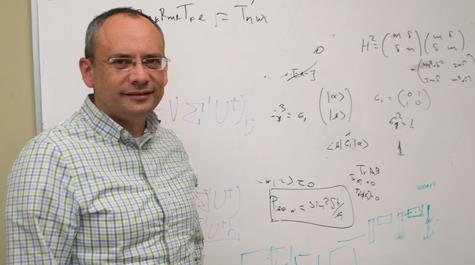Konstantinos Orginos named a Fellow of the American Physical Society
William & Mary physicist Konstantinos Orginos has been named a Fellow of the American Physical Society.
Being named an APS Fellow is a significant honor. Only half of one percent of the current membership of the APS is recognized each year for advances in research, teaching or other contributions to physics.
Orginos, an associate professor in the university’s Department of Physics, was nominated by the APS Division of Nuclear Physics, “For innovative developments and applications of lattice QCD algorithms and techniques that provide unique insight into low-energy QCD, ranging from nucleon structure to charmed hadron spectroscopy to multi-nucleon systems.”
QCD, Orginos explained, stands for quantum chromodynamics, a theory of the interactions inside the nucleus of an atom. Protons and neutrons are composite particles — as opposed to the electron, a fundamental particle.
“The proton and neutron are made out of smaller particles that we call quarks and gluons,” he said. Orginos added that the quarks and gluons are bound by the strong force, one of the four fundamental forces of nature, along with gravity, electromagnetism and another nuclear interaction known as the weak force.
“In order to understand the properties of the protons and neutrons, you have to do numerical calculations, this is what lattice QCD is.”
Orginos said that even though QCD is a relatively simple theory, the low energies within atomic nuclei call for complex mathematics to fully describe the workings of the strong force and the quarks and gluons. The lattice QCD field today is characterized by a quest for greater precision.
“When the field began, people were happy to see even crude features of what we observe,” he said. “These days people do more and more precise computations. In order to achieve the desired precision, you need to combine analytical methods and numerical techniques together with state of the art supercomputers.”
As the field has advanced, the requirements of lattice QCD calculations exceed the capabilities of paper-and-pencil and even common computers.
“We use big computers,” he said. “We use the biggest computers there are. We need even bigger computers to achieve higher and higher precision.”
Orginos has made important contributions to the field, including calculations of properties of the proton, as well as simple nuclei such as the helium nucleus and the deuteron — a one-proton, one-neutron isotope of hydrogen.
“These types of calculations are in their infancy,” he said. “They’re not very well developed. They are very challenging. This is where I spend most of my time.”
Orginos is the newest APS Fellow in William & Mary’s Department of Physics, joining nine other full-time faculty members as well as a number of emeritus and adjunct faculty who have received the APS honor.














